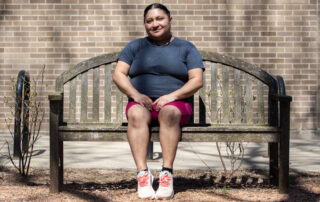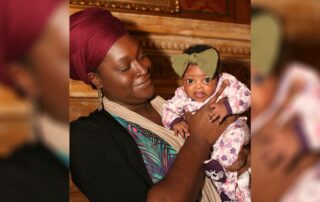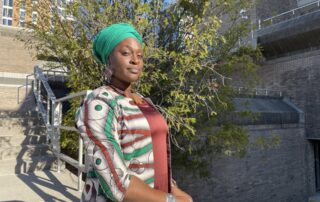Cellphones, laptops, battery-operated flashlights, our electronics are getting smaller and our need for energy is getting larger. So what if there was a way to take those items and mix them with your everyday routine to create an eco-friendly way to recharge them? That’s the bright idea of Marianne Fairbanks who has two degrees in fiber arts. She classifies herself as a textile nerd and she is also an Assistant Professor of Textiles and Design at the University of Wisconsin in Madison. Fairbanks says, “I love teaching this because everyone has a relationship to cloth. It’s the first thing you touch as a baby. You are wrapped in a blanket. Every culture weaves. Every culture dyes. Every culture creates clothing to shelter themselves.”
Fairbanks is on the cutting edge of an eco-friendly solution-based design revolution. She is trying to crack the code of renewable energy, making it accessible, and weaving it into our everyday lives. Back in 2003, she first infused art with a flexible solar plane to create a hand bag that could harness the sun’s energy to recharge cellphones or other small electronics. Fairbanks said, “We showed it around a bit and people said, ‘Well, where can I buy one?’ And we were like what do you mean? This is just an idea. This is just a prototype.”
Fairbanks came to the University of Wisconsin, she met a chemist by the name of Trisha Andrews. Andrews had made a solar cell on a piece of paper and if you think about it, paper’s actually quite similar to a textile. Fairbanks had a new idea to make a weave so the solar cells and fabric become one.
Let’s say someone need to charge tons of batteries in the military or at a refugee camp, here is your bolt of cloth, unfurl it on the field and you have a light-weight, immediate power source where you can plug in cellphones, flashlights or medical equipment. The ideas are endless when fabric is used as the actual solar cell. “I mean let’s face it. Our demand for energy isn’t going to go away,” Fairbanks said.
The next new thing might be a Wisconsin Textile movement along the lines of buy local. Fairbanks has had the opportunity to write a grant to activate a local textile and clothing culture here in Wisconsin. She is now working with an engineer and hopes to create a statewide textile network. She is also excited about an organization called Fiber Shed. It looks around at what is happening to create sustainable textiles that can contribute to buying local. Fairbanks explains it this way, “So, we have taken the local food movement and everyone just sort of understands that now. Look at the popularity of the farmers market. It’s amazing. I guess our goal with identifying who are the farmers, who are the growers, who can process the material, who can weave the cloth, who can make the clothing, it is to try to create this textile loop in Wisconsin.” At this point, it just another idea, another seed planted to create a new economy around local and sustainable textiles and clothing.
Fabrics and Feminism
Men have always dominated in the textile industry while women were involved in the production of domestic textiles and the art. UW Assistant Professor of Textile and Design talks about the evolution of fabric in our society.










